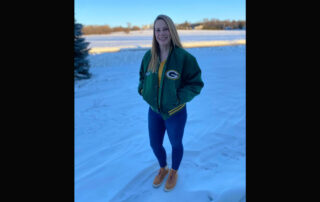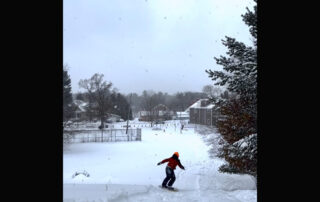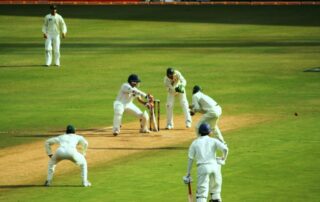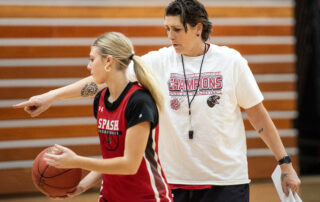Game day at Lambeau Field in Green Bay has a party atmosphere. There is a sea of fans, a few bands playing the “Packers Polka” and tailgaters as far as the eye can see. But before any of the green and gold faithful can come marching in, it is game on for Allen Johnson and his crew.
Johnson describes his job like this, “I tell people all the time I’m a farmer. And I’m growing a crop, it just happens to be for a football team.” Johnson is the Field Manager for the Green Bay Packers. He’s responsible for one of the most iconic pieces of sports turf in America. It’s a job that’s pressure packed, “You think about what you do is seen for three hours on TV by millions of people. So there’s a lot of pressure. It’s best not to think about it”, Johnson said with a nervous laugh.
For Johnson and his crew the big day is the day before when they are painting the field, and getting it ready. They paint every letter, every NFL Logo and every hash-mark, every week the Packers play at home. It requires about 45 man hours to complete. Despite using approximately 145 gallons of paint, their artwork doesn’t last long on a canvass that stretches the length of a football field because as the grass grows out the paint gets cut-off. The five man crew works the entire day prior to a Packers home game and each time they try to repaint perfection.
Each season that canvass is brand new. “What a lot of people don’t realize is every spring on Lambeau Field we actually kill off the grass, and remove it mechanically with a machine and we have to grow that back in from seed”, Johnson said. And for good reason, according to Johnson it’s all about the players, “If we let the grass get too mature, and too thick it will be harder for those cleats to break through and sink in where the good footing is. The Packers want those cleats to penetrate the grass canopy and sink down into the sand the synthetic fiber” Without that solid footing there could be more injuries to the athletes. The perfect football field has some give in it, but not so much give that it’s unstable. People always say oh, it’s a natural grass field. Oh, it’s tearing up. Well that’s a good thing. Would you rather have some grass come out and clumps of grass come out or a players knees?” So a good field has some give to it, but what’s really important is the footing. Johnson added, “So my goal is always to have it full, have a nice cushion of grass for the players to land on, and from an impact standpoint. But not so dense that their cleats can’t get through it.”
Another little known fact, Lambeau Field is based on a synthetic and natural turf perfected overseas. Johnson added, “Almost all of the soccer in Europe, the soccer fields in the Premiere League are this type of system. They’re a high-performing field. They can take a lot of rain, and a lot of water, and perform well for the athletes. Right now we are the only field with this type of system.”
Weather can also play a role in the legend and lore of Lambeau Field. “Everything is dictated by the weather. Because of sand you have to pay attention to the water.
It doesn’t hold water as long as a native soil field would. So more frequent watering is required,” Johnson said. The Packers also use another technology that really came in handy when they expanded the seating in the south end zone of the stadium. That created large shadows on the field late so grow lights are used to balance the daylight. The lights are on large, fold out arms, and they help extend our growing season. “We are unique in the sense that we are a natural grass field. Probably the northern most in latitude. We measures the amount of light we’re getting down on the field and we also have a device that measures soil temperature, air temperature, soil moisture, pretty much everything else we need to know.”
The growing season is pretty short in Green Bay, shorter than the rest and it is obviously bitter cold in the winter months. Which brings us to the term “frozen tundra”. It’s a bit of a misnomer these days because the field is actually heated. “If you were to take everything away, you would see a maze of tubing. It’s just circulating anti-freeze, and we can adjust the temperature,” Johnson said. So what about the rumors that the Packers can change the field temperature to favor the home team? Johnson is quick to add, “Impossible to change the temperature of the field that quick. It’s like the temperature of Lake Michigan. The temperature of Lake Michigan changes gradually. Soil temperatures don’t change overnight. It takes hours to change that temperature.”
Sometimes the stress from the weather can even keep Johnson awake at night. Johnson explains one of his most memorable weather incidents. He said, “It was forecasted to rain the night before the game. So we had the tarp on the field. It just sounded horrible, and I couldn’t sleep. I had these visions of the tarp being ripped up and into the stands. In the middle of the night I was driving in, and there were big bolts of lightning and thunder, just down pouring. I got to the tunnel and looked and the tarp was still on the field, but it had ripped open and large parts of the field were exposed.” Johnson says he has weathered many storms with the Packers.
Johnson grew up two hours north of Green Bay in the Upper Peninsula of Michigan and he really is a farm boy. He went to college after serving in the Army and has a degree in public administration. After graduation he found himself in Green Bay working for an insurance company. “I didn’t like being stuck in a cubicle. So I was really unhappy, and I actually ran on my lunch hour to the job service center a few blocks away to look for other work. And one day I found a little post-it note–literally a sticky note that said temporary construction. It said see Steve in the construction trailer in the Lambeau Field parking lot. I had no idea what it was about, so I went there after work, met the fella. He had a company that went around the country building golf courses and high-end athletic fields, and at the time he was hired to rebuild the Packer’s field. I quit my job the next day and went to work for him, helping rebuild the field.”
Despite not having any experienced, 19 seasons later that job on a Post-it note turned out pretty well for Johnson. He added, “It’s a really, really good fit for me and my personality. I love the freedom. The Packer’s give me a lot of responsibility, it’s my job to make it good. It represents the team. It represents the community of Green Bay. I’m fussing and fidgeting over that crop to make it as perfect as it can be it’s just not grow it, plant it, and forget it and whatever happens. You are always monkeying with it all the time.”
And while you’re watching the Packers on the field, Johnson has another job. He said, “Every NFL field has to measure their field hardness and report it to the league. It’s something to make sure the playing surface meets a minimum level of safety.” On game day his crew is responsible for setting everything up along the field. During the game Johnson is assessing conditions, “I’m watching the game, I probably don’t watch it like other people. I watch that kickoff returner, and if he’s making a sharp cut, the receivers if they’re cutting good, and I’m watching that footing. So that’s how I watch it. That’s what I do on game day.” Each week he’s require to file a report with the league.
Johnson says the goal is the same whether the Packers win the Super Bowl every year or have an NFC Championship game every year or have a pre-season game. It’s got to be the best it can be all the time. Johnson said, “I don’t think people understand the sheer amount of the size and the strength that they’re pushing on each other, and the effect that that has on the grass. It’s a lot of wear. If they didn’t play football on it, it’d be easy.”
If you ask this “farmer” what make his grass prairie special he’ll give you a green and gold answer, “It’s because it’s Packer turf, that’s why it’s special.”










